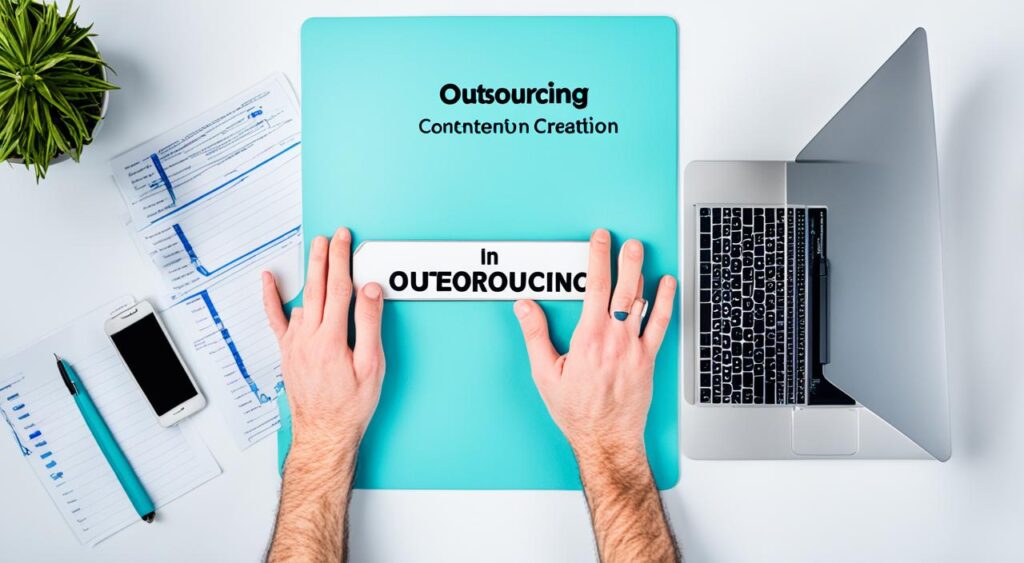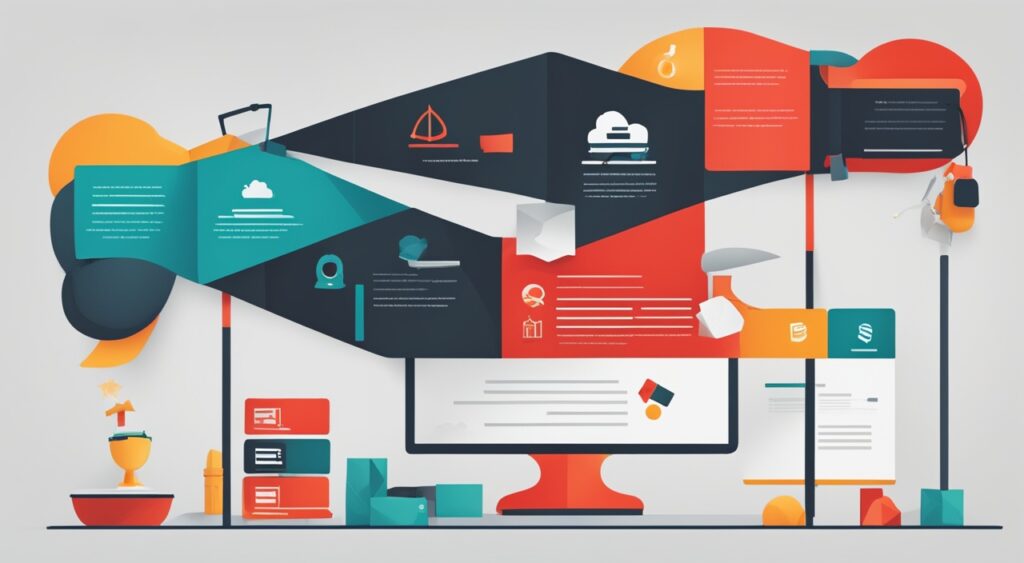Companies today fight for attention on many digital platforms. They need engaging, high-quality content to stand out. But, making this content non-stop takes a lot of time, resources, and know-how. Small and medium-sized businesses (SMBs) often struggle with this.
They face the big question: should they outsource content creation or do it themselves? The choice depends on things like budget, what they can do themselves, their skills, and if it fits their brand.

Key Takeaways
- Outsourcing can save money and help make more content fast, but it might be hard to keep the brand’s voice and rules.
- Creating content in-house gives more control and a better understanding of the brand, but it can cost more over time.
- Using both in-house and outsourced content can offer the best of both worlds, giving a safety net and keeping competition sharp.
- When deciding between outsourcing and in-house content, think about your budget, what you can do yourself, and your marketing goals.
- Having consistent, high-quality content is key to grabbing customers, hitting sales targets, and making your brand more visible.
Understanding Outsourcing and In-House Content Creation
Businesses must decide whether to outsource or create content in-house. Each method has its own benefits. The choice depends on the company’s goals and needs.
What is Outsourcing Content Creation?
Outsourcing content creation means hiring outside experts like freelancers or agencies. This way, businesses get a wide range of skills and can focus on their main tasks. Outsourcing helps improve content quality and SEO by using diverse talent.
What is In-House Content Creation?
In-house content creation uses the company’s people or a special content team. This method gives full control over the content and keeps it in line with the brand. It ensures consistent messaging and high-quality content marketing.
| Outsourcing Content Creation | In-House Content Creation |
|---|---|
| Access to diverse talent and expertise | Tighter control over brand voice and quality |
| Scalability and flexibility | Deeper understanding of brand and culture |
| Cost efficiency | Direct oversight and management |

Choosing between outsourcing and in-house content creation depends on many factors. These include business goals, budget, and the need for certain skills. By considering the pros and cons, companies can pick the best approach for their content marketing goals.
Benefits of Outsourcing Content Creation
Outsourcing content creation has many benefits for businesses. One big plus is cost efficiency. Working with an outside content creator helps avoid the costs of a full-time team, like salaries and benefits. This makes making content more flexible and affordable.
Another big plus is the ability to scale quickly. Content needs can change fast, and outsourcing lets you easily adjust production without hiring more people. This is key in today’s fast digital world.
Access to Diverse Talent and Perspectives
Outsourcing gives businesses a chance to work with a wide range of talents and creative perspectives. By working with outside experts, companies can get skills and ideas they might not have in-house. This leads to content that grabs the audience’s attention and makes a bigger impact.
Also, outsourced content creators keep up with the latest trends and best practices. This means the content stays fresh and relevant. It helps businesses stay ahead and connect better with their audience.
By using the perks of outsourcing content creation, businesses can save money, grow easily, and tap into a wide range of talent and creative perspectives. These benefits can help a company’s content marketing do well. They can lead to more visibility, engagement, and new leads.
Challenges of Outsourcing Content Creation
Outsourcing content creation has many benefits but also some challenges. Keeping a consistent brand voice and following brand guidelines can be tough with outside help. It’s key to talk clearly and work together well with the outsourced team. This ensures the content fits the brand’s identity and message.
Maintaining Brand Voice and Guidelines
Creating content in-house means the team knows the brand well. But, outsourcing can make keeping the brand’s unique voice harder. It’s vital to have strong brand guidelines and brief outsourced partners well. This helps make sure the content shows the brand’s personality and message right.
Communication Barriers
Good communication is crucial with remote teams. Differences in language and culture can lead to misunderstandings and delays. Agencies might not always be in touch with the client, making things harder. To fix this, set clear communication rules, have regular meetings, and work together well with the outsourced team.
| Challenge | Impact | Mitigation Strategies |
|---|---|---|
| Maintaining Brand Voice and Guidelines | Inconsistent brand identity and messaging in outsourced content | Develop comprehensive brand guidelines Provide thorough briefings to outsourced partners Foster close collaboration and feedback loops |
| Communication Barriers | Misunderstandings, delays, and misalignments | Establish clear communication protocols Schedule regular check-ins and progress updates Encourage open and transparent collaboration |

By tackling these issues, companies can use outsourcing to their advantage. They can keep their brand’s voice strong and work well with their outsourced partners.
Advantages of In-House Content Creation
Outsourcing content creation has its perks, but so does having an in-house team. With an in-house team, companies have more control over making content. This ensures it matches the brand’s values and rules perfectly.
Also, an in-house team gets to know the brand well. They understand its unique cultural alignment. This leads to content that feels real and connects well with people.
Greater Control Over the Process
Keeping content creation in-house means companies can keep a close eye on every step, from the first idea to when it goes live. This helps make sure the content fits the brand’s voice and look. It makes the brand’s message clear and consistent to everyone.
Deeper Understanding of Brand and Culture
An in-house team is part of the business every day. They get the brand’s culture and values. This knowledge helps them make content that truly shows what the brand is all about. It builds a stronger bond with the audience.

Outsourcing: The Key to Efficient Content Production
Many businesses find the best way to make content is by using a mix of outsourcing and having an in-house team. Outsourcing lets companies use the strengths of others at a lower cost. It also means they can grow fast and use many different talents. But, they must make sure their outsourced content fits their brand and goals.
Outsourcing content means getting help from experts without the high costs of hiring them full-time. Making content in-house has its costs like hiring, training, and buying equipment. Outsourcing lets companies grow, work faster, and get help from a wide range of experts.
Outsourcing firms can make content quickly, keeping marketing plans on track. Good communication and clear rules help keep the quality of outsourced content high. It’s important to pick a good outsourcing partner by checking their skills and past work.
In the B2B world, there’s a lot of content needed like white papers and social media posts. Outsourcing helps make more content with less effort. This way, companies can make clear, interesting, and timely content. Working with professional writers and designers helps keep the brand’s voice and style.
Think about outsourcing when you’re struggling with writing, keeping content consistent, meeting deadlines, or updating designs. Outsourcing can make content better and cheaper because it needs less editing. The key is to make sure the outsourced content fits the brand and goals.
| Outsourcing Benefits | In-House Benefits |
|---|---|
| Cost-effective access to specialized professionals Ability to scale content production quickly Diverse talent pool and expertise | Greater control over the content creation process Deeper understanding of the brand and culture |
By mixing outsourcing and making content in-house, companies can find the best balance. This balance helps them make content that is efficient, high quality, and true to their brand.
Conclusion
There is no single best way for all companies to make content. The best method depends on the company’s unique needs, resources, and goals. Whether to make content in-house, outsource it, or do both, clear guidelines and good communication are key. It’s also important to keep an open mind to new ideas and views.
Choosing the right content creation strategy helps businesses make content that speaks to their audience and grows their brand. Things like outsourcing, in-house skills, and optimization strategies need careful thought. This ensures the best way to make content for the company.
Deciding to outsource or keep content creation in-house isn’t the same for every business. Companies must look at the pros and cons of each option. They should think about their specific needs and resources. This way, they can make content that grabs their audience’s attention and helps achieve their business goals.
FAQ
What is the difference between outsourcing and in-house content creation?
Outsourcing means hiring others, like freelancers or agencies, to make content. In-house means making content with your team.
What are the benefits of outsourcing content creation?
Outsourcing can save money and help grow your content fast. It also brings in different skills and ideas.
What are the challenges of outsourcing content creation?
Outsourcing can make keeping your brand’s voice consistent harder. It can also be tough to talk to a team that’s far away.
What are the advantages of in-house content creation?
Having your team means you control all steps of making content. You know your brand’s voice and style well, making your content more real and interesting.
How can businesses strike a balance between outsourcing and in-house content creation?
Use outsourced content for its efficiency and talent. Keep your in-house team for control and brand focus. This way, you get the best of both worlds for your goals and resources.














